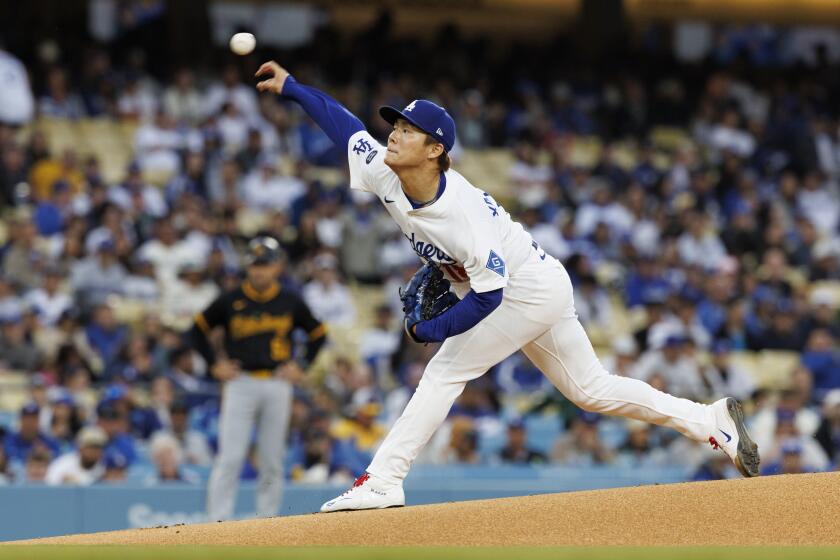
- Share via
Less than a month ago, Tyler Glasnow couldn’t have sounded more confident.
After tossing five shutout innings in his season debut against the Atlanta Braves on March 31, the oft-injured 31-year-old Dodgers pitcher believed he had finally unlocked the secret to better health.
That night, the 6-foot-8 right-hander said his mechanics felt “really synched up;” following offseason changes to the spine angle, release point and thought process behind his long-limbed delivery.
He spoke highly of the tweaks he had made in his offseason training regimen — including, notably, the elimination of heavy balls from his winter throwing program — and took his encouraging early results as a sign they’d “really been working.”
- Share via
Most of all, Glasnow described pitching with “athletic and free” mechanics on the mound; having seemingly found the kind of comfortable delivery that has so often eluded him over an injury-plagued 10-year career.
“My body just feels a lot better,” Glasnow said. “It’s moving more fluid.”
Less than a month later, those quotes ring hollow.
On Monday, Glasnow was placed on the injured list with what the team called shoulder inflammation — shelving the pitcher for the foreseeable future after he left a start on Sunday after just one inning with what he described as a “grabbing” sensation in his shoulder.
There was no immediate timeline for how long Glasnow (who has had at least one IL stint every year since 2019, save the pandemic-shortened 2020 season) might be out.
There was no set plan yet for what his recovery will look like, either, with both the pitcher and the team going back to the drawing board to figure out how to keep him healthy.
“I think we’re all just — as Tyler said — very frustrated,” manager Dave Roberts said, “and trying to get to the bottom of it.”
Indeed, the most frustrating element of Glasnow’s injury setback is that it might be rooted in the health-conscious changes he made over the winter.
After undergoing Tommy John surgery in 2021, then sustaining a season-ending elbow tendinitis injury last year, Glasnow looked to revamp his delivery. He felt his old mechanics — in particular, a habit of letting his front side fly too far open on each pitch — was putting stress on his long-troubled elbow.
At first, Glasnow’s new throw seemed to be the fix.

Even before his season debut, he said repeatedly in spring training that he felt healthier physically and more freed up mentality, hopeful he could pitch a full season for the first time in his career.
“I feel really comfortable with what I worked on,” he said. “I’ve kind of changed a ton of stuff.”
Just five starts into the season, however, things had changed.
And as Glasnow theorized Sunday, his new throw might be an unintended culprit.
“Anytime you change something [you’ve] done for a long time to try to prevent an injury, I think it’s just other things are taking over,” Glasnow said Sunday. “There’s more stress on one part, and then I compensate doing something else. I don’t even know what it is or what’s going on. I’m just trying to figure out, like, why it is that something new seems to be happening.”
That’s why, as Glasnow hit the injured list Monday, Roberts wasn’t sure how his recovery process would look.
Tyler Glasnow embarked on something of a reinvention this offseason — altering everything from his throwing program, to his pitching grips, to his mental approach.
There is no structural damage in Glasnow’s shoulder. The team didn’t even feel like an MRI was necessary, with Glasnow reporting only shoulder discomfort and “overall body soreness” when he arrived at the ballpark.
Instead, Glasnow is out because — despite his early optimism — his new delivery was not allowing him to pitch pain-free.
“My position is, when you have somebody that is complaining about things, certainly a pitcher, you’re very cautious to prevent against any type of injury,” Roberts said.
Exactly when Glasnow will be back is another question, with Roberts saying his absence could “be a tricky one as far as timeline” as he works through a new round of changes to his delivery.
“In spring training, he felt good with the new delivery, until he didn’t,” Roberts said. “So I just really can’t speak to that.”
Roberts added: “For me, if we’re going to do this, then let’s make sure that we have everything taken care of, as far as the mechanics, the physical part of it. So when we do get him back, then we can just move forward without looking back.”

For now, the Dodgers are looking ahead with uncertainty when it comes to the rest of their pitching staff.
Tony Gonsolin (out since the end of spring training with a back injury) will return to the rotation Wednesday. Ben Casparius (a rookie swingman in the bullpen) could be stretched out to handle a starter’s workload.
But Blake Snell remains out with his own bout of shoulder inflammation (he recently received a pain-reducing injection, Roberts said, and does not have a timeline to begin a throwing program). Clayton Kershaw is still three weeks away from being eligible to return from the 60-day injured list. And Shohei Ohtani isn’t expected back on the mound until at least the midway point of the season.
It leaves the Dodgers with currently just four healthy starters (Yoshinobu Yamamoto, Roki Sasaki, Dustin May and Gonsolin once he is activated Wednesday) as they approach a grueling portion of their schedule (starting Friday, they will play 19 games in 20 days).
“Honestly, I just really don’t know how it’s going to play out in the next week to 10 days,” Roberts said of the team’s upcoming pitching plans, which could include spot starters from the minor leagues and/or a reliance upon pre-designated bullpen games (which will be their plan Tuesday).
“Pitching,” he added, “is certainly volatile.”
More to Read
Are you a true-blue fan?
Get our Dodgers Dugout newsletter for insights, news and much more.
You may occasionally receive promotional content from the Los Angeles Times.












